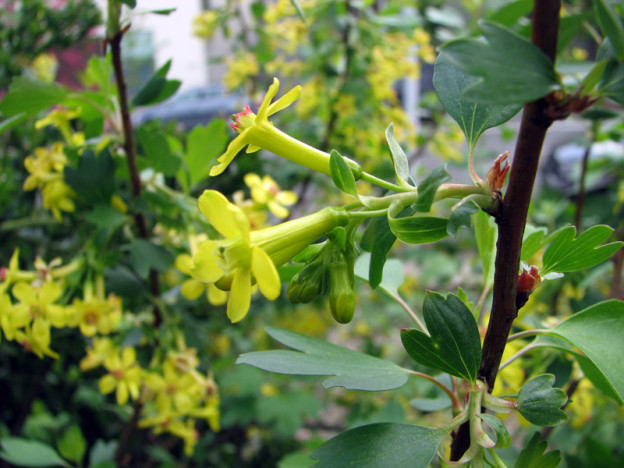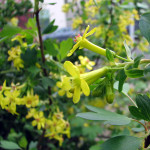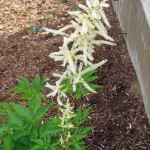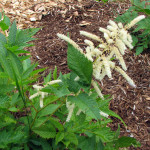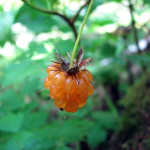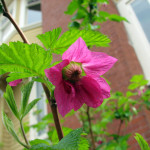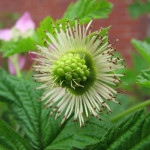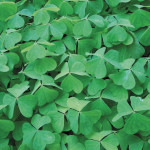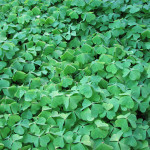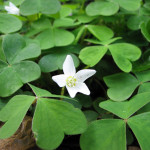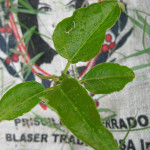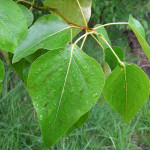Ribes aureum
Golden currant (Ribes aureum) is a small to medium-sized deciduous shrub named for its golden flowers and golden red fall foliage. It is common in Oregon and Washington east of the Cascades and into the Great Basin.
Golden currant grows in full sun and partial shade, in dry to moist conditions, and is drought tolerant. The leaves are deciduous, lobed, and vaguely maple-like, ½ – 1½ inches. Charming clusters of yellow flowers bloom from mid- to late-spring. Golden currant grows to approximately 6 feet tall by 6 feet wide.
It attracts hummingbirds and butterflies such as the spring azure and mourning cloak, and the fruit is eaten by birds and other wildlife. Combine this in a sunny spot with its cousin, red-flowering currant, and drought-tolerant groundcovers like alliums and camas, for a beautiful native display!
- Light Requirements: Full Sun, Part Shade
- Water Requirements: Dry, Moist
- Ease of Growing:
- Growth Rate: Moderate
- Spreads: No
- Wildlife Support: Hummingbirds, Birds or Mammals
- Fire-resistant: No
- Edible: Yes
- Mature Height: 6ft
- Mature Width:6ft
Goat’s Beard

Aruncus dioicus
Goat’s Beard has decorative finely-cut foliage and will create a bold, showy effect for a moist or partly-shaded spot all season. Dense, feathery plumes of tight white flowers rise well above the foliage spring to summer.
Goat’s Beard is an excellent background plant or grouped in a woodland setting. It dies back to the ground in winter, only to return gloriously in the spring. Goat’s Beard spreads slowly by rhizomes to form attractive patches, and can be planted in more sunny areas provided there is good moisture. It’s a “host” plant to the Dusky Azure Butterfly.
- Light Requirements: Part Shade, Full Shade
- Water Requirements: Moist, Perennially Wet
- Ease of Growing: Easy to grow
- Growth Rate: Fast
- Spreads: Yes
- Wildlife Support: Pest-eating Insects, Birds or Mammals, Pollinators
- Fire-resistant: No
- Edible: No
- Mature Height: 5-15ft
- Mature Width:3-5ft
Deer Fern
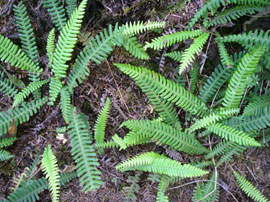
Blechnum spicant
Blechnum spicant is a species of fern known by the common names deer fern or hard fern. It is native to Europe and western North America. Like some other Blechnum it has two types of leaves. The sterile leaves have flat, wavy-margined leaflets, while the fertile leaves have much narrower leaflets. Deer fern is a major understory plant in most moist coniferous forests in our region.
- Light Requirements: Part Shade, Full Shade
- Water Requirements: Moist, Seasonally Wet
- Ease of Growing: Moderate
- Growth Rate: Slow
- Spreads: No
- Wildlife Support: Birds or Mammals
- Fire-resistant: Yes
- Edible: No
- Mature Height: 1-3ft
- Mature Width:2ft
Salmonberry

Rubus spectabilis
Salmonberry (Rubus spectabilis) is an upright shrub growing to 10 feet tall, with a unique vase-like shape and prickly stems. The purple-magenta flowers bloom April through June. The orange-red, raspberry-like fruit matures in late summer to early autumn.
Salmonberry is a great wildlife plant for a large yard or garden; the open flowers attract bumblebees and hummingbirds while the fruit is a treat for thrushes, tanagers, finches, and wrens. Native bees also use it extensively for nesting material and winter shelter.
Salmonberries grow in moist forest openings and stream margins, so it does best in full sun to part shade and moist to wet soils. They often form large thickets, and thrive in the open spaces under stands of red alder.
- Light Requirements: Full Sun, Part Shade, Full Shade
- Water Requirements: Moist, Seasonally Wet
- Ease of Growing: Easy to grow
- Growth Rate: Moderate
- Spreads: Yes
- Wildlife Support: Pollinators, Hummingbirds, Pest-eating Insects, Birds or Mammals
- Fire-resistant: No
- Edible: Yes
- Mature Height: 4-10ft
- Mature Width:4-10ft
Willamette Valley Ponderosa Pine
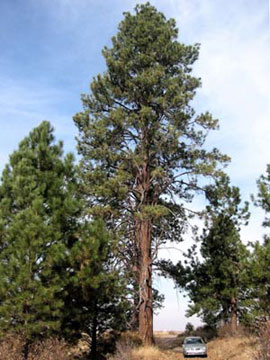
Pinus ponderosa
Willamette Valley Ponderosa Pine (Pinus ponderosa var. benthamiana) is a beautiful tree with long needles and attractive bark. Like all ponderosas, the bark of this tree has a vanilla-like scent when warmed by the sun–and they love sunny spots! However, the Willamette Valley Ponderosa is the only variety of ponderosa that can also withstand the heavy wet winter soils of our region.
This long-lived tree is very valuable for wildlife. Its needles are the only known food for gelechiid moth (Chionodes retiniella) caterpillars. Many species of birds and small mammals eat the nutritious seeds and use the needles for nesting material; others use cavities and branches for nesting and shelter.
Willammette Valley Ponderosa Pine is one of four different varieties of Ponderosa Pine, each adapted to different climatic conditions and with differing botanical characteristics. When planting in Multnomah County, it is very important to use this variety, as it is the only one that will thrive in our region.
- Light Requirements: Full Sun
- Water Requirements: Dry
- Ease of Growing: Easy to grow
- Growth Rate: Fast
- Spreads: No
- Wildlife Support: Pest-eating Insects, Birds or Mammals
- Fire-resistant: Yes
- Edible: No
- Mature Height: 150-200ft
- Mature Width:25-30ft
Western Hemlock

Tsuga heterophylla
Western hemlock (Tsuga heterophylla) is the state tree of Washington, and the largest species of hemlock, growing up to 200′ tall with a trunk diameter of up to 4′. It makes a beautiful addition to any property where it has room to grow.
Western hemlocks grow into a narrow, upright, somewhat ragged cone as they grow, with very top of the tree typically drooping over just a little bit. The needles are short and flat, averaging less than 1″ long. The small round cones dangle from the branches and have long, thin, flexible scales. The bark is thin, brown, and furrowed in texture.
This tree is an important source of food for many birds and mammals. Yellow-bellied sapsuckers nest in the tree’s cavities, and barred owls prefer dense stands of Western hemlock. Flying squirrels and other small mammals nest in hemlocks, and many animals browse the inner bark and young needles and take shelter in the dense foliage.
Western hemlock is a very shade-tolerant tree, with young plants able to grow under a closed canopy of fast-growing, shade-intolerant conifers such as Douglas-fir. Disturbances like fire or logging open up sunny areas where new generations of Douglas-fir and other sun-loving seedlings can survive, but without that disturbance, hemlocks end up dominating the canopy…and Western hemlocks can live up to 1200 years old! If you are in a forest made up of mostly large hemlocks, you know that forest has been undisturbed for a very long time.
- Light Requirements: Full Sun, Part Shade, Full Shade
- Water Requirements: Dry, Moist
- Ease of Growing: Easy to grow
- Growth Rate: Fast
- Spreads: No
- Wildlife Support: Pest-eating Insects, Birds or Mammals
- Fire-resistant: No
- Edible: No
- Mature Height: 120-200
- Mature Width:30-40ft
Oregon Oxalis
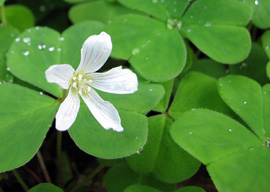
Oxalis oregana
Oxalis oregana, also known as Redwood sorrel, is a species of the wood sorrel family, Oxalidaceae, native to moist Douglas-fir and Coast Redwood forests of western North America from southwestern British Columbia, Washington, Oregon, and California. This attractive groundcover can spread vigorously when planted in favorable conditions.
It is a short herbaceous perennial plant with erect flowering stems 5-15 cm tall. The three leaflets are heart-shaped, 1-4.5 cm long on 5-20 cm stalks. The inflorescence is 2.4-4 cm in diameter, white to pink with five petals and sepals. The hairy five-chambered seed capsules are egg-shaped, 7-9 mm long; seeds are almond shaped.
Oregon oxalis photosynthesizes at relatively low levels of ambient light (1/200th of full sunlight). When direct sunlight strikes the leaves they fold downwards; when shade returns, the leaves reopen. This process only takes a few minutes and the movement is observable to the eye.
The tangy leaves of Oregon oxalis were eaten by Native Americans, probably in small quantities, since they contain mildly toxic oxalic acid (hence the genus name).
- Light Requirements: Part Shade, Full Shade
- Water Requirements: Moist
- Ease of Growing: Easy to grow
- Growth Rate: Moderate
- Spreads: Yes
- Wildlife Support: Birds or Mammals
- Fire-resistant: Yes
- Edible: Yes
- Mature Height: 6-8in
- Mature Width:2-3ft
Black Cottonwood

Populus trichocarpa
Balsam poplar (Populus balsamifera) is the northernmost American hardwood, and grows across the continent. Though it appears in upland areas, it thrives in floodplains. It is our tallest native broad-leaved tree, and has dark grey bark. In the spring and early summer the sticky resin on leaf buds releases a strong, balsamic fragrance. It is hardy, fast-growing, and relatively short-lived, though some trees have been known to live for 200 years. Other names are balm-of-gilead, bam, tacamahac, cottonwood, or heartleaf balsam poplar.
Wildlife
The leaves of the balsam poplar serve as food for various caterpillars in the order Lepidoptera. It is an important browse for deer and elk and provides nesting habitat for large birds. The anti-infectant property of the resin is used by bees, who seal intruders in it to prevent decay and protect the hive.
Uses
A great riparian restoration species. The light, soft wood is used for paper pulp and construction lumber.
- Light Requirements: Full Sun, Part Shade
- Water Requirements: Dry, Moist, Seasonally Wet, Perennially Wet
- Ease of Growing: Easy to grow
- Growth Rate: Fast
- Spreads: No
- Wildlife Support: Birds or Mammals
- Fire-resistant: No
- Edible: No
- Mature Height: 175ft
- Mature Width:40ft

